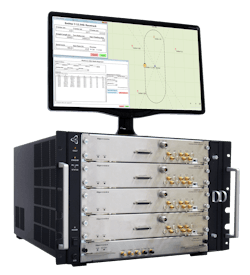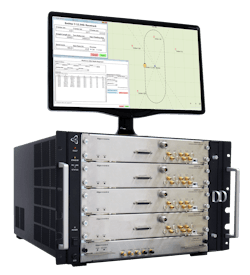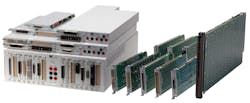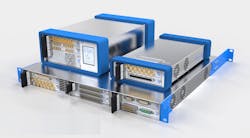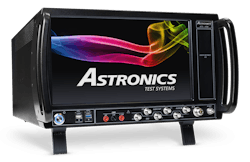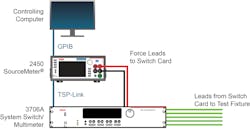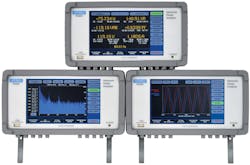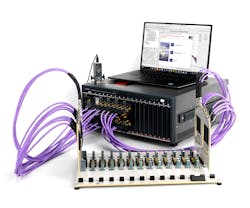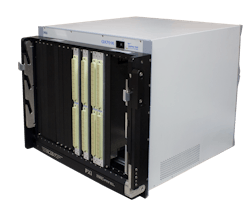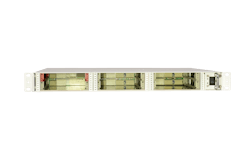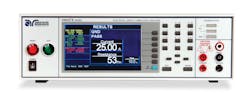Special Report: Leveraging modularity from measurement hardware to DFT software
Download this article in .PDF format.
The term “modular” in the context of electronics test and measurement suggests industry-standard architectures like AXIe, PXI, or VXI, which define physical and electrical specifications for modular instruments and chassis. LXI relaxes the physical constraints but lets you interconnect your choice of electrically compatible instruments and compute resources. Similarly, USB configurations allow you to take a modular approach to selecting interconnectable measurement units and computers.
Many manufacturers are continuing to innovate on these platforms, yet others are pursuing proprietary modular approaches. The concept of modularity can extend from instrumentation all the way to design-for-test software, where a hierarchical approach creates retargetable test functionality.
Giga-tronics supports AXIe with its Advanced Signal Generation and Analysis Platform, according to John Regazzi, CEO, and Dan Kirby, vice president of business development. “Modular platforms are primarily advantageous in applications requiring multiple stimulus and measurement channels,” they said. “For example, simulating the many radar and EW signals experienced in a modern battlespace usually requires many signal generators. Stacking separate benchtop units not only takes up valuable rack space, but coordinating their behavior to generate multiple emitters often requires additional hardware to phase-lock their signals together.”
They noted that with the Giga-tronics AXIe platform, each signal generator is a blade that slides into a chassis that includes the infrastructure to share reference and control signals, thereby simplifying the job of simulating many emitters. “One nice thing about the AXIe platform is that the standard has a provision for a customizable section of the backplane, which allows a supplier to add specific capability for enhancing their offering’s functionality,” they added.
Chris Gibson, senior product manager, VTI Instruments, a product line in AMETEK’s Programmable Power business unit, defined “modular test” as the capability to integrate source, measure, and switching instrumentation modules through a backplane into a single mainframe. “Modular systems offer more flexibility andGibson elaborated on the three different modular test instrument platforms that VTI offers. “The VXI platform provides large-sized modules for high-performance, high-density testing, typically in mission-critical, military/aerospace applications,” he said, adding that VTI’s VXI modules are individually shielded to maintain signal quality.
Gibson said the LXI platform provides a way to interface to external controllers and workstations through the LAN interface. Because the platform does not have dimensional requirements, the platform can be more cost-efficient while offering high-density and flexibility for switching modules, he explained. “VTI LXI mainframes have an analog backplane for direct, internal connection of multiplexed signals to a measurement instrument, such as a 6½-digit digital multimeter,” he said. “The analog backplane maximizes signal integrity through the system and eliminates external wiring between switching modules and a DMM.”
Gibson said that with the PXIe platform, modules can communicate with the backplane at up to 2 GB/s, explaining that PXIe is suited for medium- to high-density automated test and data-acquisition systems.
Stasonis said modular test platforms have been around for more than 30 years. Some are proprietary, where only one supplier’s modules can fit into the chassis. In contrast, open standards such as PXI allow vendor interoperability, meaning any vendor’s PXI modules can plug into any vendor’s PXI chassis.
Proprietary modular platforms give the supplier more flexibility to tailor mechanical and performance characteristics that are specific to their offering, whereas open platforms such as PXI offer a broader range of instrumentation, giving the end user more flexibility in creating a modular test system, Stasonis said.
Craig Hughes, senior manager, instruments, Astronics Test Systems (ATS), defined a modular test architecture as an adaptable design that can add or remove functions by hardware and/or software methods, allowing designers to configure a system to their needs. “When the architecture is based on COTS components“Modular test typically refers to a class of switching and instrument solutions that require an external chassis to function; the chassis provides power, a high-speed backplane for communications and timing, and a controller,” said Jon Semancik, director of marketing at Marvin Test Solutions (MTS). “Rack-and-stack instruments, on the other hand, integrate the desired functionality in a standalone enclosure that typically only requires line power and a communications interface.”
Semancik said MTS designs and manufactures PXI-based instrumentation and switching cards, in both 3U and 6U form factors, with products offered with PXI and PXIe interfaces. “PXI is the most widely adopted modular test architecture in the industry, scalable from smaller benchtop applications to large multibay test systems,” he said. “The ability to mix and match 3U and 6U devices in a single combination chassis is also a major advantage.
“We define modular tests as a combination of a wide choice of different hardware components on common buses and a universal software API to access these,” said Oliver Rovini, technical director at SPECTRUM Instrumentation. “SPECTRUM supports the PCIe, PXIe, and LXI platform.”
Each has its own advantages, according to Rovini. “PCIe is common and can be found in nearly every PC system; therefore, it’s easy scalable from small low-cost systems to high-end server systems with massive GPU processing,” he said. “PXIe offers a mechanical, stable industry platform but has a higher system cost. LXI instruments are easiest to integrate as they are based on Ethernet connection and can be operated in any network, remotely or directly from a laptop.”
Mark Pickard, product management director at VIAVI Solutions, said, “Modular test is a paradigm that offers hardware and software components that can be configured into customized solutions to meet specific customer test needs. These modular solutions can be modified and scaled to evolve along with the customer’s test requirements.”
Subbaiah Pemmaiah, application engineer, Copper Mountain Technologies (CMT), commented that increased test complexity is driving the need for flexible test instruments for lab, production, and field test environments. “These instruments need to be easily maintainable, have fewer potential points of failure, have adequate memory storage space, be inexpensive, and yet produce fast, accurate, and reliable measurements,” he said.
To meet these requirements, CMT introduced USB vector network analyzers for which the measurement module is separated from the processing module. “USB VNAs bring the measurement data to any external Windows or Linux PC using the VNA software,” Pemmaiah explained. “All data manipulation (except for digitization) and control occurs on the external PC.”
Keithley offers several interface options. “Our modern instruments support all the basics—USB, LAN, GPIB, etc.—and most support LXI control with their own webpages for simple remote capabilities,” Odhner said. “However, our go-to architecture is Keithley's Test Script Processor (TSP). TSP is an aspect of our instruments' firmware that allows the execution of code written by the user, similar to how one might program an Arduino.” TSP includes an extensible communication bus called TSP-Link, which allows Keithley’s instruments to send commands and share data. “In this way, our customers can create ‘mainframe-less networks’ of instruments that can be seamlessly expanded,” he said.
“Newark offers two main types of modular test products: software-based and hardware-based modular architectures,” said Maureen Lipps, product manager. “Many modular test architectures are a combination of both hardware and software.”
Lipps said software-based modular architectures usually consist of one piece of test equipment with all the features built into the hardware. “A customer can add or later purchase a software package or bundle which activates each of the extra features that they need,” she said. “The advantages of software modules are that initial costs are minimal, the system can be designed for specific needs, and it can be upgraded immediately with a key code or download.” However, she said, future upgrades are limited by initial hardware setup.
“Hardware-defined modular test products consist of a mainframe or chassis base unit which usually consists of a power supply, bus communication, and a reference clock along with slots for hardware modules for various test operations,” Lipps continued. Hardware modules are usually plug-and-play and are flexible. “As with software architectures, the initial costs can be minimal and can be configured for specific needs,” she said.
According to Christian Fischer, senior director, product management, T&M systems and projects at Rohde & Schwarz, a modular test platform allows the configuration of a tester by different hardware modules to meet a specific application. “This configuration and exchange of modules is very easy and can be performed also by the end-user,” he said. “This means one tester can be configured for different applications without the need to change to a different tester. Functionality which is not needed can be removed”—thereby achieving minimum cost and footprint.
Nicholas Piotrowski, product manager at Ikonix USA, defined “modular test” as a test setup that allows the user to add test points to the system to expand production and/or capability. He cited several modular architectures the company supports, including the OMNIA II 8204/54 Series electrical safety compliance analyzer from the company’s Associated Research Division in combination with the 620L LineCHEK II leakage tester. “The OMNIA II 8204/54 allows for ground-bond, AC/DC-hipot, and insulation-resistance testing,” he said. “The addition of the 620L expands the electrical safety testing capability to include LCT (leakage current testing) to test leakage current in product insulation while the device is operating.”
Piotrowski also described the company’s SC6540 scanning matrix as “completely modular,” offering eight to 16 channels for multipoint ground bond and/or hipot testing. “A master module can be linked with up to four slave modules to get up to 80 channels,” he said. “Any number of masters can be added to the system for an infinite number of test points if need be.”
Design for test
Jay Jahangiri, product manager, Tessent ATPG and compression products for Mentor, a Siemens Business, addressed modularity with respect to the company’s Tessent family of semiconductor design-for test software products. “In the context of DFT used by chip designers, modular test refers to the approach of segmenting the design into smaller modules for DFT,” he said. “Similar to the divide-and-conquer approach of tester instruments, the chip design is broken down to allow performing DFT tasks such as test logic insertion and pattern generation on smaller portions of the design.”
Jahangiri said that historically modular test referred to performing DFT at lower design levels (or cores), but often work was done from the chip level, which still required the entire chip design to be loaded into the tools. “Today’s ‘modular test’ is better described as ‘hierarchical test,’ which is the practice of inserting test logic and creating retargetable test at lower design levels and being able to verify and sign off all DFT work early in the design flow,” he said, adding that the approach allows for DFT work to be performed on cores concurrently and much earlier than when the full chip-level design becomes available.
“In addition to improvements in implementation, hierarchical DFT provides significant reduction in pattern count and test time, diagnosis costs, machine resources, and more,” Jahangiri said. “Furthermore, an optimal hierarchical DFT flow takes DFT out of the critical path and is able to easily handle late-stage design changes (ECOs).”
Modular hardware
Gibson at VTI described several of the company’s modular products. The EX1200-3604 and EX1200-3608 LXI modules are 4- and 8-channel isolated DACs with 200-VDC and 200-VAC peak isolation; the EX1200-7416 LXI comparator module enables the capture of signals as narrow as 1 µs for detection of glitches; the EX1200-7008 LXI RTD simulator simulates up to eight RTD sensors for testing and calibrating an RTD-based temperature monitoring system; the EX1200-7600 LXI programmable load module presents resistances from 0.5 Ω to 1.5 MΩ, which can be used both to test power sources and to calibrate test sources; the EX1214-ICA LXI mainframe (with an integrated test adaptor) eliminates cabling between the DUT and the test modules; and the EX1200 LXI switch modules enable users to define switch-closure configurations that cannot be enabled to avoid creating switch paths that can cause damage to the system or to the DUT.
“VTI’s goal is to maximize the life of its modular products for all customers,” Gibson said. “VTI supports all modular instrument standards for interoperability, and software drivers provide the flexibility to work with any test software on any operating system.”
Stasonis said Pickering Interfaces is known for its selection of switching and simulation products in the PXI formfactor. “To address newer market demands, we have created a line of modular chassis that are controlled by either LXI/Ethernet or USB and can accept virtually any of Pickering’s range of PXI switching and simulation modules,” he said. “This chassis range goes from two slots to seventeen slots.” These chassis serve applications that need a few extra slots of switching as well as remote switching-only applications, they simplify interfacing with a PC controller, and they can isolate electrically noisy switching from instrumentation, he added.
“We have also created switching systems based on LXI/Ethernet and USB control with a proprietary modular design that has certain advantages over PXI in specific applications,” Stasonis continued. “The advantages include larger PCB real estate for very dense switching, internal backplane buses for easy expansion of a matrix, and higher DC power to control more relays simultaneously.”
Hughes at Astronics Test Systems said the company offers chassis, instruments, switching subsystems, and integrated systems using modular architectures such as AXIe, LXI, PXI, and VXI. “In addition, we provide configurable and modular test system solutions,” he said. Specific products include the ATS-3100 PXI integration platform for system development, the PXIe-6943 32-channel pattern-based digital stimulus/response instrument, the PXIe-2461 2-channel, universal 235-MHz frequency and time interval/counter, the PXIe-1803 130/180-MS/s dual channel PXI Express digitizer, the PXIe-3352 PXI rubidium standard (which combines a rubidium oscillator with a GPS receiver), the PXIe-1209 fully programmable dual pulse generator, and the PXIe-1802 2-channel AWG.
In addition, Hugues said, the company offers an RF and digital switching product line, including ASCOR switching products, CTS-6000 Series communications testers, and the ATS-6100 wire fault tester. Astronics also sells the Tabor product line, including the new Proteus arbitrary waveform transceivers, he added.
Semancik also said that the GX7016 GENASYS switching subsystem features a compact footprint and the option to support both switching and instrumentation resources within a single PXI chassis. An integrated MAC Panel SCOUT receiver provides a “cable-less” receiver interface, eliminating thousands of wires.
According to Fischer, “Rohde & Schwarz offers the modular platform R&S CompactTSVP, which is based on PXI, but with a lot of additional features not covered by the standard PXI.” It includes modules for analog test, digital test, and in-circuit test, with switching modules from 1 A up to 50 A. “All measurement modules are floating,” he said, adding that third-party PXI modules can be integrated into the R&S CompactTSVP by means of an additional 6-slot 1U chassis extension. “A specific mass interconnect interface from Virginia Panel allows direct connection of the receiver to the R&S CompactTSVP modules without any additional cabling,” he added.
Rovini at SPECTRUM said the company has focused on fast and high-resolution digitizers and AWGs. “Their sampling speed ranges from 1 MS/s to 5 GS/s,” he said. Key products include PCIe cards with one to eight channels, which could be combined to build extended systems with more than 100 synchronous channels.Lipps at Newark described several modular products the company offers. “The Keysight U2781A USB modular instrument chassis is a high-performance 4U chassis that comes with a 200-W universal AC power supply and a built-in protection circuit,” she said. “This portable chassis can house up to six Keysight USB modular products. This chassis supports Keysight USB modular data acquisition (DAQ) and USB modular instruments (digital multimeter, arbitrary waveform generator, oscilloscope and source measure unit).”
Newark also offers the Keithley Integra 2750 DMM/data-acquisition/datalogging system with GPIB and RS-232 interfaces, she said, adding, “The Keithley 2750 combines the functions of a DMM, switch system and datalogger with five slots for modular plug-ins. Users have a choice of 12 switch/control modules including RF modules and multiplexers.”
In addition, Newark offers the B&K Precision MDL001 modular DC electronic load. “The MDL001 is a multichannel modular electronic-load system which provides four slots for various DC loads,” she said. “B&K and Newark offer a choice of seven different modules of programmable DC loads ranging in power from 200 W to 600 W, providing users the flexibility to test a wide range of power sources.”
She added that Newark offers software-upgradeable instruments, including the Tektronix MDO3000 Series oscilloscope (which offers software modules/upgrades to add an arbitrary function generator, logic analyzer, and serial protocol trigger and analysis capability) and Rhode & Schwarz FPC1500 spectrum analyzer (for which key-code options can unlock up to 3-GHz performance).
According to Odhner at Keithley, “We currently lean towards the discrete instrument side of modularity. We often find that chassis-based systems are confusing and cumbersome to the large portion of engineers that don't operate their equipment exclusively over a remote interface.” He added that for Keithley instruments that support TSP, such as the Model 2450 source-measure unit, customers get the benefits of a single-box instrument plus the speed and synchronization of a modular system.
“That said, we do offer several instruments that take qualities from chassis-based instruments,” he continued. “The Keithley 4200A-SCS, for example, is a parameter analyzer with nine customizable instrument slots for current-voltage (I-V), capacitance-voltage (C-V), and ultra-fast pulsed I-V instruments.”
Jim Shaw, Diversified Technical Systems’ director of sales and marketing, said, “DTS manufactures the smallest, most rugged, modular data-acquisition systems on the planet. DTS DAQ can be positioned on or in small test articles without altering test dynamics. User-configurable SLICE data recorders are designed to be embedded close to the point of interest, reducing complex and costly sensor wiring and improving measurement quality.” He added that DTS modular instrumentation offers dynamic measurement capabilities including acceleration, shock, vibration, and angular rate. Shaw added that DTS miniature SLICE DAQ can be integrated with other modular architectures via an API or run out of the box using DTS software.
Pemmaiah at Copper Mountain Technologies said all his company’s VNAs are USB-based metrology-grade instruments. “Our 2-port Compact Series and 1-Port Series network analyzers deliver lab-grade performance despite being very compact in size. The patented 1-Port VNA can even be directly connected to an antenna or other DUT without the need of a test cable,” he said.
AXIe products
Addressing AXIe, Giga-tronics offers an upconverter and downconverter for building test solutions used in the evaluation of radar and EW systems. “These converters cover 100 MHz to 20 GHz with 1 GHz of instantaneous bandwidth; they switch frequencies phase coherently in under 1 µsec and offer low phase noise, harmonics, and spurs,” said Regazzi and Kirby. “The company also offers two AXIe-compliant chassis—a 4U size handling two channels and a 7U version that can house up to four separate converter blades. It’s possible to mix and match up- and downconverters within the same chassis.”
They continued, “To assist in the coordination and phase stability between channels, Giga-tronics produced a separate frequency reference module that supplies reference signals to each converter blade and allows tying multiple chassis together for larger systems. This reference module takes advantage of AXIe’s Zone3 provision within the standard and shares its reference signals across the backplane eliminating a patchwork of cables on the front panel.”
Regazzi and Kirby emphasized Giga-tronics’ converter approach to signal generation and analysis. “For example, rather than creating a traditional signal generator and post modulating the output, the company chose to build a converter that allows modulation at the IF,” they said. “This means the modulator needs only operate at one frequency and simplifies optimizing performance over a wide instantaneous bandwidth. And because of advances in ADC and DAC technology, the digital portion of the solution can now be directly provided at the IF from digital cards plugged into open PCIe slots within a standard PC workstation.” The cost-effective COTS approach, they added, allows customers to upgrade as technology improves, permits customers to add their own IP and other third-party hardware, and makes for easier servicing of the resulting test system. “Delivering the RF blades in a modular format is the best approach for the target market due to the need for multiple channels of stimulus and measurement,” they concluded.
According to Pickard at VIAVI Solutions, “The CMP provides a highly scalable computing, signal-processing, and automation framework. Its modular hardware and component-based software support rapidly tailored solutions that are easily upgradeable and reconfigurable. Utilizing the Software Communications Architecture (SCA) and modern ‘real-time’ CORBA, it scales from embedded single-processor systems up through fully distributed heterogeneous systems of various CPU, FPGA, GPU, and DSP assets running multiple operating systems and communicating over multiple bus-interface architectures.”
Pickard said VIAVI’s CMP is architected similarly to a software-defined radio (SDR). “Like SDR, the CMP is implemented using generic hardware modules and component-based, software-defined functionality,” he said. VIAVI’s AXIe products include a mass data-storage module with up to 12.8 TB of waveform storage, a 6-GHz vector signal transceiver with 30-GHz Downconverter module, a single or dual i7 embedded computer module, 5- and 2-slot AXIe chassis, the Ranger vector signal analyzer and generator system, and the Raptor integrated development and test platform.
“The new Raptor versions of our CMP are configurable for use as a development platform as well as a test system and can provide both functions simultaneously,” said Pickard. “Due to the platform’s modularity, we can even implement solutions that integrate the combined functionality of our Raptor systems and our Ranger signal-generation, analysis, record, and playback platforms.”
From DFT to maintenance software
Jahangiri at Mentor elaborated on the company’s Tessent family of DFT products, which include automation software that analyzes the design, creates and inserts the necessary hardware instruments for test, generates and retargets patterns, and performs silicon diagnosis and yield analysis. Specific Tessent products include MemoryBIST, LogicBIST, TestKompress (for compression and ATPG), MissionMode (for on-chip mission mode control), and ScanPro (for inserting scan, test points, OCC, and wrapper chains). In addition, Tessent Diagnosis supports scan diagnosis, Tessent IJTAG supports universal access based on IEEE 1687 standard, and Tessent Connect supports optimal implementation flow and automation.
“Tessent’s DFT flow is the industry’s only production-proven hierarchical solution that enables the customer to fully automate their core-level DFT tasks, as well as all top-level logic and core interactions,” Jahangiri added.
Semancik at MTS said, “ATEasy is a comprehensive test executive and a rapid application development framework for functional test, ATE, data acquisition, process control, and instrumentation systems with exceptional cybersecurity protection and controls. ATEasy provides all the necessary tools to develop, deploy, and maintain software components—including instrument drivers, test programs, and user interfaces—as well as a complete and customizable test executive.” He added, “For OEM suppliers of test systems, ATEasy-Lite offers a cost-effective, full-featured test executive and test development software suite that can be bundled with the suppliers’ ATE systems.”
Shaw at DTS commented, “DTS offers standalone test setup, control, and data logging software that is purpose-built for dynamic, embedded applications that require rugged modular data acquisition. Our software is designed to work out of the box with modular DTS data-acquisition hardware. For applications that require integration with other modular architectures, we provide an API that can be called from most popular languages used in test such as C/C++/C#, LabVIEW, and Matlab.”
“VTI includes a full suite of industry standard IVI drivers for use in the most common application development environments, such as LABVIEW, LabWindows/CVI, C++, and Visual Basic,” said Gibson. “In addition, the operating system-independent drivers will operate in both the Windows environment and the Linux environment.” He added that both the LXI and PXIe platforms have an embedded web browser and graphical user interface (GUI), and The LXI platform has a turnkey test package called EXLab, which allows engineers to design a mixed-signal, distributed measurement system without any coding.
“Astronics Test Systems has a wide variety of product offerings and solutions in the test industry; therefore, we support the most widely used test development and sequencing software packages (LabVIEW, TestStand, LabWindows/CVI, Visual Studio etc.),” said Hughes. “We also have many test development and runtime packages that we have created as point solutions to best operate on our integrated test solutions—TestVue, TestCUE, and CTE, to name a few. These are all Windows-based test development and runtime environments meant to address the needs of the different industries we serve.”
Regazzi and Kirby at Giga-tronics said the company offers a software package called Advanced Signal Control for programming the up and downconverter within an ATE environment. “Rovini at SPECTRUM said the company supports all major programming software like C++, VB.NET, C#, J#, Delphi, Java and Python plus third-party software tools like LabVIEW and MATLAB, so the instruments can be easily integrated into the software packet of the customer’s choice. “Alternatively,” he said, “users can run our own software, SBench 6 Professional, which lets users control all the modes and settings of the hardware via an easy-to-use interface with built-in features for data-analysis and documentation.”
Pemmaiah commented on the software for CMT’s USB VNAs. “The VNA application driving the analyzer module runs on an external PC,” he said. “This application is bundled up with all features a user would expect from a VNA along with time-domain, gating, and mixer/converter measurement capabilities which are standard features in the software.”
“We serve a wide range of applications and markets, and we have architected our software platform so that it supports virtually all of the popular application development environments (LabView, Python, C++, .NET and many others), as well as Windows and Linux operating systems,” said Stasonis at Pickering Interfaces. “We also offer IVI driver support across our major product families.” In addition, he said, “Our Switch Path Manager signal-routing software gives application developers the ability to program complex switching systems using logical end names of signal paths.” And finally, the company offers maintenance software called BIRST and eBIRST, which runs automated switching-module self-tests that pinpoints the source of failure during troubleshooting. “This significantly reduces the repair cycle time as modules can be repaired in the field in a fraction of the time it would normally take to send the unit back to the OEM for repair,” he concluded.
About the Author

Rick Nelson
Contributing Editor
Rick is currently Contributing Technical Editor. He was Executive Editor for EE in 2011-2018. Previously he served on several publications, including EDN and Vision Systems Design, and has received awards for signed editorials from the American Society of Business Publication Editors. He began as a design engineer at General Electric and Litton Industries and earned a BSEE degree from Penn State.
